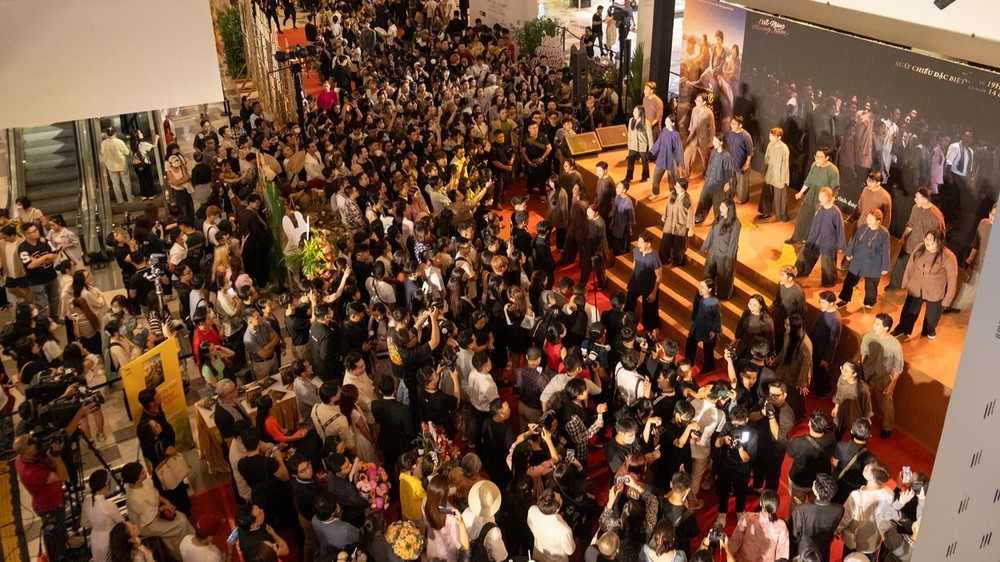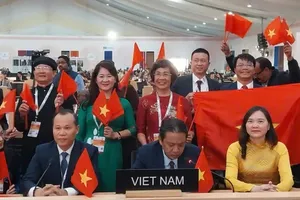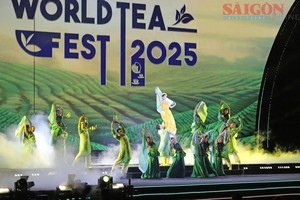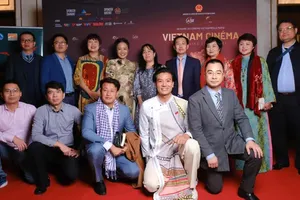Great potential
According to Ms. Nguyen Thi Thanh Thuy, Deputy Director of the HCMC Department of Culture and Sports, the city identifies eight cultural industries, including film, performing arts, fine arts, photography, exhibitions, advertising, cultural tourism, and fashion. In the field of cinema, the city boasts 873 out of a total of 17,670 cultural enterprises. However, considering the production value of cultural industries up to 2020 (the last year with available statistics), the film industry contributed VND3,367 billion (out of the total of VND36,732 billion for all cultural industries), ranking below advertising and exhibitions but significantly surpassing cultural tourism, fine arts, and photography.
 |
A large number of audience attend a special screening of the film "Dat Rung Phuong Nam" in Ho Chi Minh City. |
The film industry in HCMC currently holds around 40 percent of the national film market share. In recent years, the film industry has made substantial contributions to the city's Gross Regional Domestic Product (GRDP), fluctuating between 0.32 percent and 0.36 percent annually. In 2019, the city's film industry revenue reached a record of VND8,040 billion before decreasing in 2020 due to the impact of the Covid-19 pandemic. Ms. Thanh Thuy evaluates that calling on investment in the film industry is the appropriate strategy. In HCMC, investment invitation brings about significant development for the city, contributing to economic growth.
Many international experts also recognize the potential of the Vietnamese film industry, especially in HCMC, as it continues to make its mark internationally. Mr. Jeremy Segay, Southeast Asia Audiovisual Attaché at the French Embassy in Vietnam, notes that the growth rate of Vietnamese cinema, including the number of theaters and the market share of Vietnamese films, is impressive.
He cites the example of the film "Ben trong vo ken vang" (Inside the Yellow Cocoon Shell) which won the Caméra D'or (Golden Camera) award for the best debut fiction film at the 76th Cannes International Film Festival. The film, upon release in France, sold over 50,000 tickets, generating approximately US$400,000 in revenue. Another highlight of Vietnamese cinema, particularly in HCMC, is the thriving development of post-production and visual effects (VFX), with many companies providing high-quality services. He also emphasizes the core factor of success - the Vietnamese audience's preference for Vietnamese films.
Meanwhile, Mr. Kim Dong-ho, the founder and former chairman of the Busan International Film Festival (BIFF) and honorary chairman of the HCMC International Film Festival (HIFF), believes that organizing HIFF is crucial. International film festivals play a vital role in a country's film market, particularly in the widespread promotion of quality works. He is confident that HIFF will be successful, just like BIFF.
Suggestions for improvement
Offering recommendations for Vietnamese cinema and HIFF, Mr. Jeremy emphasizes the importance of strengthening dialogues to better understand the industry's dynamics. Mr. Kim Dong-ho cites the establishment of the Busan Film Commission as a pioneering and essential factor in the success of the Busan International Film Festival in South Korea today. Drawing inspiration from this model, numerous other cities in South Korea have adopted and emulated it, offering specific support to film crews visiting. Mr. Jeremy concurs with this perspective, stating that organizations like these serve as places where filmmakers can seek essential support and explore databases on film production locations.
Mr. Jeremy Segay, Southeast Asia Audiovisual Attaché at the French Embassy in Vietnam: The development of the film industry requires state-private cooperation.
In countries like South Korea and many European nations, governments provide financial policy support for filmmakers. They take charge of film production, while the government promotes films globally. Mr. Jeremy suggests finding an effective way for both parties to collaborate and reach a consensus, a matter that deserves special attention.
Regarding the organization of HIFF, Mr. Kim Dong-ho stresses the importance of choosing the right timing, similar to BIFF, rather than scheduling it at the end of the year, which makes it challenging to attract tourists. Additionally, he recommends having different cultural festivals every day during the event. In terms of professional activities, he suggests that HIFF, in its early stages, should not focus on the film market as it would be challenging to compete with already successful models. Mr. Jeremy agrees, proposing that HIFF concentrate on a project market to introduce, promote, connect investors, and attract talented young filmmakers from around the world.
Acknowledging these suggestions, Ms. Thanh Thuy says that the HCMC Department of Culture and Sports is currently advising city leaders on initiatives and mechanisms to establish a Film Development Fund to support talents in the coming years. At the national level, there is ongoing research to develop specific policies to promote the domestic film industry, such as prioritizing Vietnamese films in screenings, imposing low taxes on Vietnamese films, and implementing policies or tax incentives for Vietnamese filmmakers to encourage and motivate future developments in the film industry.
























